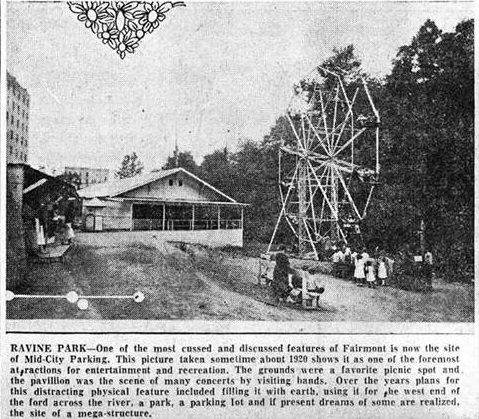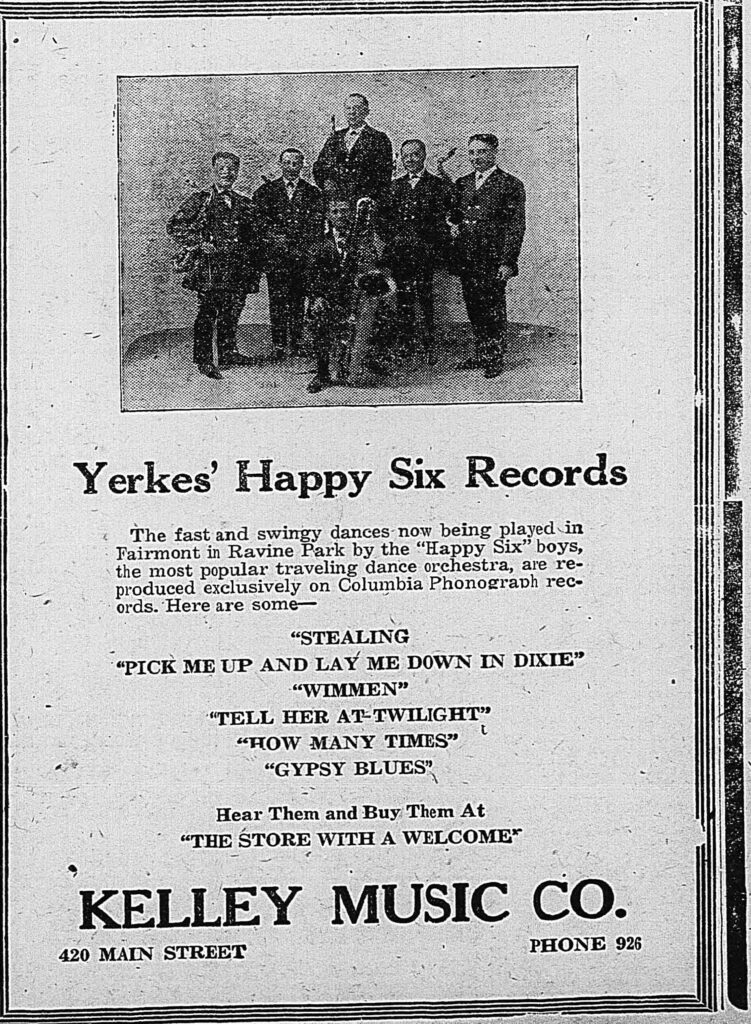
Ravine Park was to be the biggest little amusement park in the area. As told in the previous part 1 of this story, the park was furnished with concession stands, a pavilion, an auditorium, and a swimming pool to keep everyone cool. Now was the time for the rides. The City bought and installed its very own Merry-Go-Round in the park. It would cost the rider a mere twenty-five cents to ride. The little and grown folks of the City enjoyed the spin of sitting on tigers and riding brightly colored horses. It was a hit.
The next large purchase would be the Ferris Wheel set next to the South Side bridge. For those adventuresome patrons, they could always ride to the top, taking in the view of the east side. They also added an airplane swing that twirled you round and round.
Not long after these rides came to the park, another business went to the City and offered its services to be added. The Parachute Amusement Company got permission to set up a stand on the South Side Bridge above the park. They used actual parachutes, and customers would pay the price to strap on the chute and jump from the bridge to the park floor below. They also had another golden offer. The ride was free if the person making the jump could sail over and land on the Ferris Wheel. Is it just me, or could you see a lot of injuries happening with this idea? But I could not find anywhere that a severe mishap took place.
Let’s move on to other attractions they had at the park. Miniature trains, a pony track [ that was just rides on the ponies for the children], a shooting gallery, and a seaplane on certain days would fly onto the river and give rides around the City.
If as that was not enough to keep you busy, they would allow side shows to come and bring in their performers. One such show was Jack Lees Sideshow, featuring Diva, the girl who drinks, eats, and sews underwater. I’m guessing that they brought their own water tank with them.
Al Siscoe’s Monkey Speedway. They made a small sanded beach area by the river, a palm grove over by the pavilion, and a large horseshoe pit area for competitions. Horseshow tournaments between local businesses were big-time activities at the time. In 1922 they even held the regional horseshoe tournament here.
They held professional skating shows at the rink; one performer, Sammy Lover Trick Performer gave them an exciting performance by skating with torches lit with gasoline, jumping barrels and tables, doing the Devil Dance,[could not find what that may be like], jumping high in the air and then bending down and picking up an American flag off the ground, and lastly, showing how he invented playing basketball on skates.
The park would have jazz concerts that featured performers from all over the country. With his presence, hometown favorite Fuzzy Knight graced the crowd on July 2, 1921.
On the park’s opening night, May 29, 1921, the Col Littleton Society Circus with his star performer, the horse with the human brain Lady Fanehon. She was said to be a white mare that could add, subtract and do many other things better than a human. The trainer would ask how many girls were in the front row,[4] and the horse would tap with his hoof the correct number. He would ask for someone’s watch in the audience, add 5 minutes to the time, and show the watch to the mare; he would then back away from the horse about ten feet. The time on the watch showed to be five after 8. The horse would tap eight times, stop for a minute, then tap five times. He was right! They say the horse would also make change when asked. Amazing!!
Meanwhile, as everyone enjoyed the great attractions, others waited anxiously for the night’s performances in the pavilion and auditorium. It was not just local talent either. On one occasion, the American Legion brought a Marimba band from Guatemala, Central America, to get everyone moving. At other times they enjoyed the Fredrick Sisters from Pittsburgh, PA. They kept them dancing all night!
A particular favorite, though, was the Yerke’s Happy Six; they got you up dancing or tapping your feet to their New Orleans jazz style. Below you can go back in time and listen to a favorite song of the time, Dance Mania:
This band was also famous for the gold instruments they played with. Shiney gold gleamed under the lights. It was said that all totaled the instruments cost around 5000 dollars. That was huge money for the time.
They also held the first auto show in the area and had fashion shows for the ladies. They held square dances, and in 1922 they had an event to unite the whole city. It was advertised that there was to be a city hayride. People were asked to come with their wagons or trucks packed to the hilt with hay and riders and line up starting on Locust Ave. When it started, they drove through the city and had a gay time.
To run an enterprise such as this costs a fortune. Electricity, wages, repairs, insurance, and concessions bubbled at the top. People wanted the fun but no longer bought the stock. Everyone wanted the fun, but at a huge loss for the company. I think the company put the horse before the cart, as they say. They bought and had all these wonderful attractions and put themselves in considerable debt.
To survive, they had to liquidate some of the assets. So on Sept. 14, 1922, the Merry-go-round and the Ferris Wheel were auctioned off. The pony track was closed. No more parachuting from the bridge, and the train left town. It was a very sad day for Ravine Park.
Especially for the park manager at the time, Reno Fleming, his pet monkey, a special friend to all the kids left from the auction block.
The park continued on with what they had left. They had local bands now, and people would mostly entertain themselves with the roller rink or horseshoe pit. The park, I’m sure, felt like the heart had been ripped out of it.
You would think the park had the worst time in its history, but in the summer of 1923, a huge storm caused so much destruction to the park due to flooding it was decided that after a couple of years of merriment, the park must close. By the end of 1923, with the park in disarray, what was salvageable was sold off, and the rest was torn down.
The city let the Ravine Amusement Company out of its lease and eventually turned it into the Mid-City parking lot. The parking lot was used many years in Fairmont for downtown shoppers to park as they went through their day; even carnivals would come to town and provide us with summer fun.
Eventually, even the Mid-City parking lot was unused when the Middletown Mall came along and took most of the business from downtown away. Now the parking lot is mostly used for storage for the city.
This has taught everyone a lesson: don’t overindulge all at once. Go slow and enjoy the ride.
Below I have put some pictures of advertisements from local newspapers at the time to show some of the fun and merriment.



I will publish a new weekly blog containing more Fairmont and Marion County history. If there is a topic you may want to explore more, please comment below, and I will research it. Please comment below, letting me know if you did or didn’t like this article. It helps me improve with your suggestions.
Thank you for taking the time to read my blog, and remember: History is the spine of America; not learning from it would make us collapse and fall!

;I enjoyed this article. When I went shopping with my aunt in the late 1950s, we always dressed nicely, and we would park in the Midcity Lot and take the elevator up to the bridge. I remember my aunt telling me that there once was an amusement park there. Your article has really told me a lot about it. My father and aunt probably would not have known it, as they were born in 1914 and 1918.
Hi Becky,
Thanks for reading my blog. I’m glad you enjoyed it. Yes, the amusement park was a unique find for me. Fairmont has a history that few remember, and no one has taken the time to tell. I hope to do that. Thanks again, and I look forward to hearing from you again.